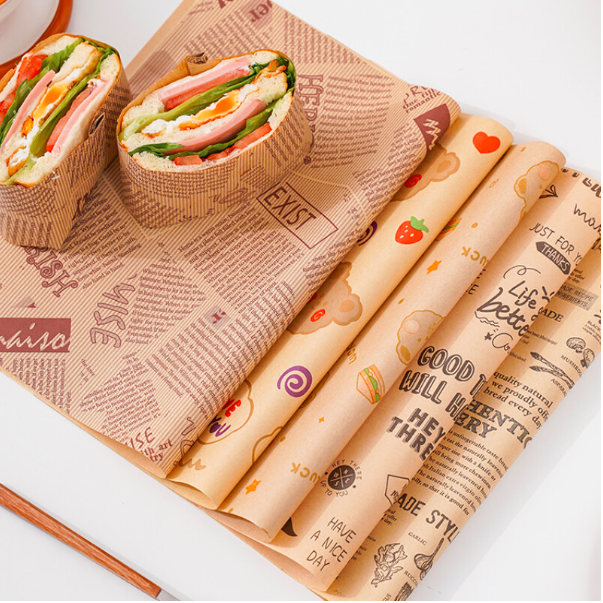In today’s fast-paced food industry, packaging has become just as important as the food itself. Beyond protecting products, Custom food wrapping paper plays a crucial role in presentation, customer experience, and even marketing. From the local bakery around the corner to major fast-food chains, wrapping paper has proven to be one of the most versatile and practical packaging solutions. Among its many variations, custom printed food paper is now taking center stage as businesses realize the value of personalization and branding in every customer interaction.
What is Food Wrapping Paper?
Food wrapping paper refers to specially designed paper used to wrap, protect, and present food items. It can range from wax-coated sheets to greaseproof kraft paper, and from delicate printed tissue to durable parchment paper. The primary function of wrapping paper is to maintain freshness, protect against contaminants, and provide a hygienic barrier between food and handling. However, its significance has expanded far beyond simple functionality. Today, food wrapping paper is also about aesthetics, branding, and sustainability.
Why Food Wrapping Paper Matters in the Food Industry
The importance of food wrapping paper lies in its multi-dimensional role. On one hand, it safeguards the food against environmental factors such as dust, bacteria, and moisture. On the other, it contributes to a product’s perceived value. Imagine receiving a pastry wrapped in plain paper versus one beautifully wrapped in branded printed food paper—one feels ordinary, while the other feels intentional and premium.
In an industry where customer loyalty is shaped not only by taste but also by overall experience, wrapping paper acts as a subtle but powerful brand ambassador.
Food Safety and Freshness
One of the biggest advantages of food wrapping paper is its ability to keep food safe and fresh. Greaseproof paper, for instance, prevents oils from leaking out of burgers, sandwiches, or fried snacks, while wax paper creates a protective layer against moisture. Parchment paper ensures baked goods like cookies and muffins remain intact and fresh even during transport. For businesses, these qualities help reduce food waste while ensuring a positive customer experience.
The Rise of Eco-Friendly Wrapping Solutions
Modern consumers are increasingly conscious of sustainability, pushing brands to rethink their packaging strategies. Traditional plastic wraps are being replaced by recyclable, biodegradable, and compostable papers that leave a smaller environmental footprint. Food wrapping paper, particularly kraft and uncoated tissue, is often recyclable and eco-friendly, making it a popular choice among businesses that want to highlight their commitment to sustainability.
Eco-friendly wrapping options not only reduce waste but also resonate with environmentally aware customers, enhancing brand reputation in the process.
Custom Printed Food Wrapping Paper: A Branding Essential
Perhaps the most significant innovation in food wrapping has been the emergence of custom printed food paper. In a competitive marketplace, standing out is critical. Custom printed wrapping paper allows businesses to display their logos, slogans, and brand colors directly on the packaging.
This transforms an ordinary piece of paper into a marketing tool. Every time a customer unwraps a sandwich or takes home a box of cookies, they are reminded of the brand. Even better, when food is shared or photographed for social media, branded wrapping paper amplifies exposure, acting like free advertising.
Restaurants, bakeries, and cafes are using this tool not only to reinforce brand identity but also to create memorable unboxing experiences that encourage repeat purchases.
Everyday Applications of Food Wrapping Paper
Food wrapping paper is used across a wide variety of businesses, each with unique needs:
- Bakeries use delicate tissue or parchment paper for cakes, pastries, and cookies.
- Fast-food chains rely heavily on greaseproof printed sheets for burgers, fries, and wraps.
- Cafés and delis wrap sandwiches, bagels, and snacks in custom printed food paper for branding impact.
- Street vendors and food trucks benefit from lightweight, affordable kraft wrapping paper.
- Retail packaging often uses branded wrapping paper to elevate the look and feel of gift items like gourmet chocolates or specialty foods.
This versatility makes food wrapping paper one of the most cost-effective packaging solutions available.
Different Types of Food Wrapping Papers
Food wrapping paper comes in a wide variety of forms, each tailored to specific uses:
- Wax Paper – Coated with wax for moisture resistance, often used for deli items, cheese, and baked goods.
- Greaseproof Paper – Designed to resist oils and grease, ideal for burgers, fries, and pastries.
- Parchment Paper – Heat-resistant and non-stick, commonly used for baked goods.
- Kraft Paper – Sturdy, eco-friendly, and often used for sandwiches, wraps, and rustic-style packaging.
- Printed Tissue Paper – Lightweight, delicate, and excellent for brand presentation.
These options provide businesses with flexibility to choose the right balance between functionality, branding, and cost.
Cost-Effectiveness and Branding Benefits
Compared to other packaging methods like plastic containers or elaborate boxes, food wrapping paper is inexpensive yet impactful. A simple sheet of custom printed paper can cost pennies but deliver significant branding value. It’s a practical solution that reduces packaging costs while maximizing customer engagement.
Moreover, because wrapping paper is lightweight, it reduces shipping and storage expenses, making it especially suitable for small businesses and large-scale operations alike.
Future Trends in Food Wrapping Paper
The future of food wrapping paper lies in innovation, personalization, and sustainability. Brands are experimenting with compostable materials, soy-based inks, and plant-derived coatings to minimize environmental impact. At the same time, digital printing technologies make it easier and more affordable for small businesses to access custom printed food wrapping paper in low quantities.
Another trend is interactive packaging—QR codes and scannable designs on wrapping paper that connect customers to digital experiences, menus, or promotional campaigns. This merging of packaging with technology reflects how even something as simple as wrapping paper can evolve with customer expectations.
Conclusion
Food wrapping paper has come a long way from being a mere necessity to becoming a critical part of branding and customer experience. Whether it’s protecting a sandwich, showcasing a bakery’s logo on custom printed tissue, or supporting sustainability goals with eco-friendly kraft paper, its importance in the food industry cannot be overstated.
For businesses, investing in high-quality and custom printed food wrapping paper is no longer just about packaging—it’s about making every meal memorable, every customer interaction meaningful, and every brand touchpoint impactful. In a competitive marketplace where details matter, wrapping paper proves that even the simplest elements can carry extraordinary value.









